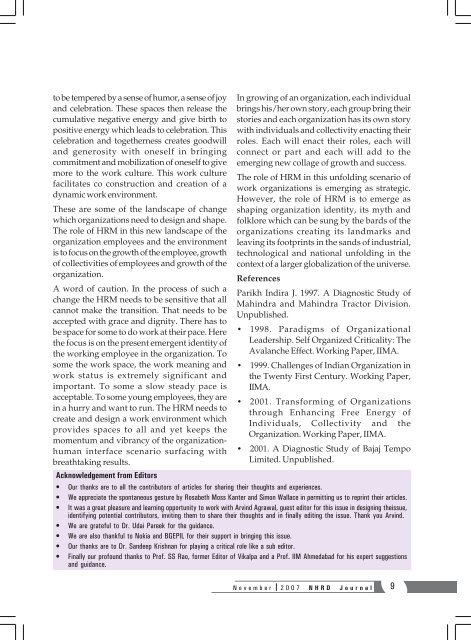NHRD Journal - National HRD Network
NHRD Journal - National HRD Network
NHRD Journal - National HRD Network
Create successful ePaper yourself
Turn your PDF publications into a flip-book with our unique Google optimized e-Paper software.
to be tempered by a sense of humor, a sense of joy<br />
and celebration. These spaces then release the<br />
cumulative negative energy and give birth to<br />
positive energy which leads to celebration. This<br />
celebration and togetherness creates goodwill<br />
and generosity with oneself in bringing<br />
commitment and mobilization of oneself to give<br />
more to the work culture. This work culture<br />
facilitates co construction and creation of a<br />
dynamic work environment.<br />
These are some of the landscape of change<br />
which organizations need to design and shape.<br />
The role of HRM in this new landscape of the<br />
organization employees and the environment<br />
is to focus on the growth of the employee, growth<br />
of collectivities of employees and growth of the<br />
organization.<br />
A word of caution. In the process of such a<br />
change the HRM needs to be sensitive that all<br />
cannot make the transition. That needs to be<br />
accepted with grace and dignity. There has to<br />
be space for some to do work at their pace. Here<br />
the focus is on the present emergent identity of<br />
the working employee in the organization. To<br />
some the work space, the work meaning and<br />
work status is extremely significant and<br />
important. To some a slow steady pace is<br />
acceptable. To some young employees, they are<br />
in a hurry and want to run. The HRM needs to<br />
create and design a work environment which<br />
provides spaces to all and yet keeps the<br />
momentum and vibrancy of the organizationhuman<br />
interface scenario surfacing with<br />
breathtaking results.<br />
In growing of an organization, each individual<br />
brings his/her own story, each group bring their<br />
stories and each organization has its own story<br />
with individuals and collectivity enacting their<br />
roles. Each will enact their roles, each will<br />
connect or part and each will add to the<br />
emerging new collage of growth and success.<br />
The role of HRM in this unfolding scenario of<br />
work organizations is emerging as strategic.<br />
However, the role of HRM is to emerge as<br />
shaping organization identity, its myth and<br />
folklore which can be sung by the bards of the<br />
organizations creating its landmarks and<br />
leaving its footprints in the sands of industrial,<br />
technological and national unfolding in the<br />
context of a larger globalization of the universe.<br />
References<br />
Parikh Indira J. 1997. A Diagnostic Study of<br />
Mahindra and Mahindra Tractor Division.<br />
Unpublished.<br />
• 1998. Paradigms of Organizational<br />
Leadership. Self Organized Criticality: The<br />
Avalanche Effect. Working Paper, IIMA.<br />
• 1999. Challenges of Indian Organization in<br />
the Twenty First Century. Working Paper,<br />
IIMA.<br />
• 2001. Transforming of Organizations<br />
through Enhancing Free Energy of<br />
Individuals, Collectivity and the<br />
Organization. Working Paper, IIMA.<br />
• 2001. A Diagnostic Study of Bajaj Tempo<br />
Limited. Unpublished.<br />
Acknowledgement from Editors<br />
• Our thanks are to all the contributors of articles for sharing their thoughts and experiences.<br />
• We appreciate the spontaneous gesture by Rosabeth Moss Kanter and Simon Wallace in permitting us to reprint their articles.<br />
• It was a great pleasure and learning opportunity to work with Arvind Agrawal, guest editor for this issue in designing theissue,<br />
identifying potential contributors, inviting them to share their thoughts and in finally editing the issue. Thank you Arvind.<br />
• We are grateful to Dr. Udai Pareek for the guidance.<br />
• We are also thankful to Nokia and BGEPIL for their support in bringing this issue.<br />
• Our thanks are to Dr. Sandeep Krishnan for playing a critical role like a sub editor.<br />
• Finally our profound thanks to Prof. SS Rao, former Editor of Vikalpa and a Prof. IIM Ahmedabad for his expert suggestions<br />
and guidance.<br />
November 2007 <strong>N<strong>HRD</strong></strong> <strong>Journal</strong> 9
















